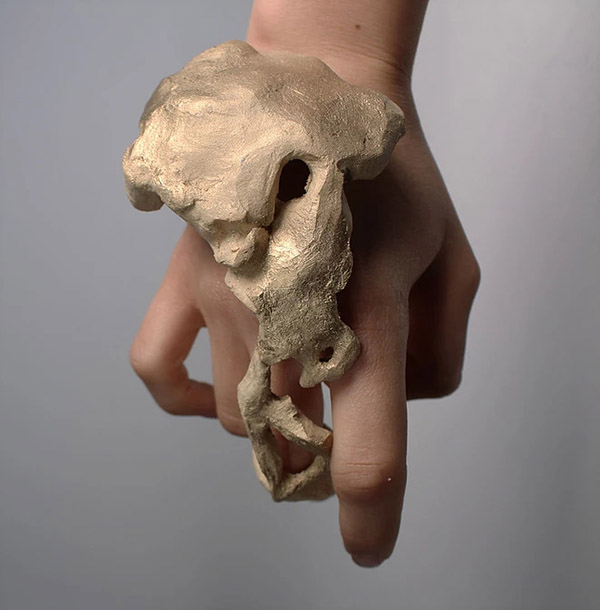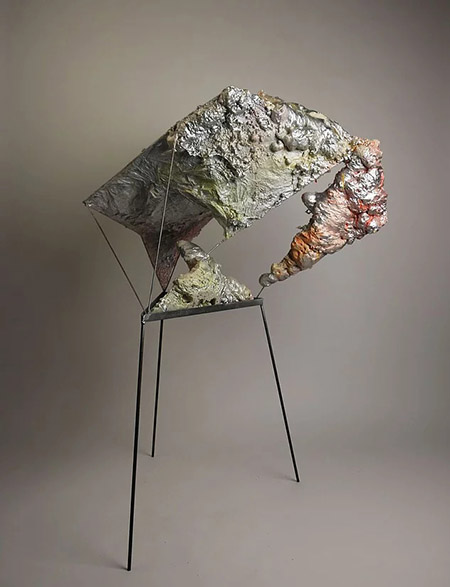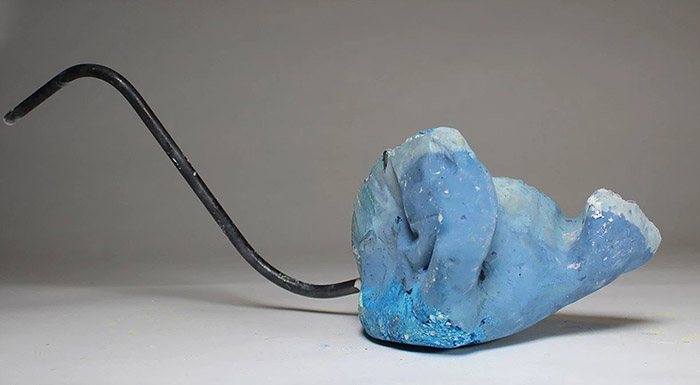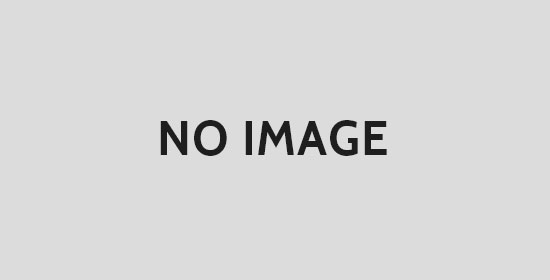Maria Cepeda is Fine Arts tudent from Leeds Arts University.
She works with sculptures to investigate the existing relationship between self-other-environment.
Work across different materials, approaching sculpting in a performative and innovative way her research is currently focused on how this relationship is studied by new materialism, stressing the impact of technology on the way we perceive our own material bodies.
She is one of the two artists selected for In Real Life residency, second of 4 artist residencies organized and curated by Artcore between 2018/2019.
We visited her in the artist studio, where we had a conversation about how she looks at her sculptures as both organic and technological elements use to reflect on future condition of human body.
Have a read of what she says!

Maria Cepeda, Wear, Ceramic, 2018
Where are you based?
I’m originally from Colombia but I’m based in Leeds
How you would like to use this residency to develop your current research and how do you think the time spent at Artcore can benefit your process of doing?
My current research deals with the idea of a saturated self that receives so much stimuli and information from its surroundings that it becomes an abstract entity that takes on multiple identities. I’d like to use the In Real Life residency to develop this by relating it directly to the cybernetic world we are all a part of- more specifically linking this idea to video games where players take on a different identity. I’m not used to planning my art practice ahead of time, and I think my time in artcore will benefit my process of making in the sense that I am working following an action plan and so will be more organized with my time.
In the proposal you mentioned you would like to question reality and our perception of it. For you is important to investigate and question ourselves about how far we can push the performative powers of our vision and perception by using mechanisms like VR before it gets overwhelmed. Why you are interest in it and how you aim to connect it with your current practice?
I’ve recently been reading a lot about new materialism and the way technology impacts the way we perceive the world and our own bodies. The concept of what is “real” is much more difficult to define now than it would have been some years ago. In the present day we can take virtual worlds as being real because we sense them that way, even if ontologically they’re not- they’re just the product of coding and exist as data in the internet. By using virtual reality in my project I’m looking at how we face dissociation from our own material bodies when we inmerse ourselves in these virtual environments- we understand the world in more abstract terms. I intend to connect this perception of the world in abstract terms to the understanding of the human in abstract terms as well, which is what my current practice aims to look at.
How and when you have decided to use the medium of clay to investigate how our contemporary society modifies the way we and others perceive our bodies?
I decided to use clay for its organic qualities that I think relate it very well to the body and its carnality. I usually mix the medium of clay with other materials like metal and plastic to make a reference to the contemporary society we live in as well. I’ve been using clay for around a year now as main medium in my practice- many consider it to be more related to crafts, and there’s a constant debate about whether or not clay belongs to the world of fine art, but in the present day more and more artists are finding in clay the perfect medium to express themselves and I think it is very valid, specially when the subject of study is the body.
What is the most interesting or inspiring thing you have seen or been to recently, and why?
I really liked going to the Material Environments exhibition in the Tetley which finished in June this year. One of the artists showing her work was Phoebe Cummings, she had built an installation using unfired clay using as inspiration sci-fi books and the way they described the worlds their stories took place in. I bought the Vitamin C: clay+ ceramics, not long before the exhibition and I loved her work, so it was great to see ceramics being used in fine art in a major gallery with my own eyes.

Maria Cepeda, New Human, Mixed media, 2018
What keeps you curious?
I read a lot, also watch movies that make me ask questions, or make me imagine things. I think the real way to be always curious is to not take things as granted, there’s always something behind what seems to be institutionalized or obvious, so just observing things with more attention and being on the lookout to new interesting things everywhere
Which other artists’ work do you admire, and why?
There’s a lot of artists I admire, right now the artists I look up to the most to are Bart Hess and Lucy McRae, because it’s amazing how they work with wearable art and digital mediums in such a brilliant way. I also really like Edmund de Waal and Richard Deacon as ceramicists.
What do you think is the role of artists who decided to work on the issues related to digital identity in the current society?
I think artists respond to their time, and most of us work in one way of another as a response to a digital era we are immersed in. The role of artists who precisely decide to work on digital identity in our current society is important as it is something many people ignore or overlook as non relevant even when it’s shaping our behaviours and understanding of the world.

Maria Cepeda, On being, Mixed media, 2017
What are your thoughts on being for two months an artist in Derby?
I think it’s a good opportunity to work in a different environment. I know working outside of your comfort zone always brings interesting results so I’m looking forward to them
How do you see Artcore, as an art institution, to support you at this stage of your career?
I think Artcore is a really good institution for artists like me, who are in the first stages of their career. It gives us a lot of tools to develop as artists in the future because It’s not only the studio space that we receive but also mentoring and support which I think are very valuable.



Leave a comment